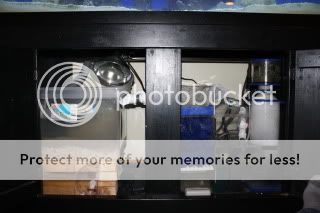SantaMonica
Reefing newb
Finally, I have a combination that has some green. Had to up the flow on the one-sided screen from 50 to 75 gph on the one screen (am not currently using the other screen), and reduce the lighting to 16 hours. Bulb is 1 inch (2.54 cm) from the screen. The bulb is setting on the bottom of the box at an angle, and the screen is also at an angle, and that's the reason that the burned-yellow part is at the bottom, and why the waterline is tilted:
(right click and "view image" to see the whole pic)

I cleaned it today, then sanded the clear window to diffuse the light. The bulb is so near to the screen that you are almost able to see the outline of the bulb in the growth. Scattering the light should help a lot; it's just a matter of how much.
To build this at home, you would just attach vinyl tubing to the pipe, and set the screen down evenly inside the box.
(right click and "view image" to see the whole pic)

I cleaned it today, then sanded the clear window to diffuse the light. The bulb is so near to the screen that you are almost able to see the outline of the bulb in the growth. Scattering the light should help a lot; it's just a matter of how much.
To build this at home, you would just attach vinyl tubing to the pipe, and set the screen down evenly inside the box.

